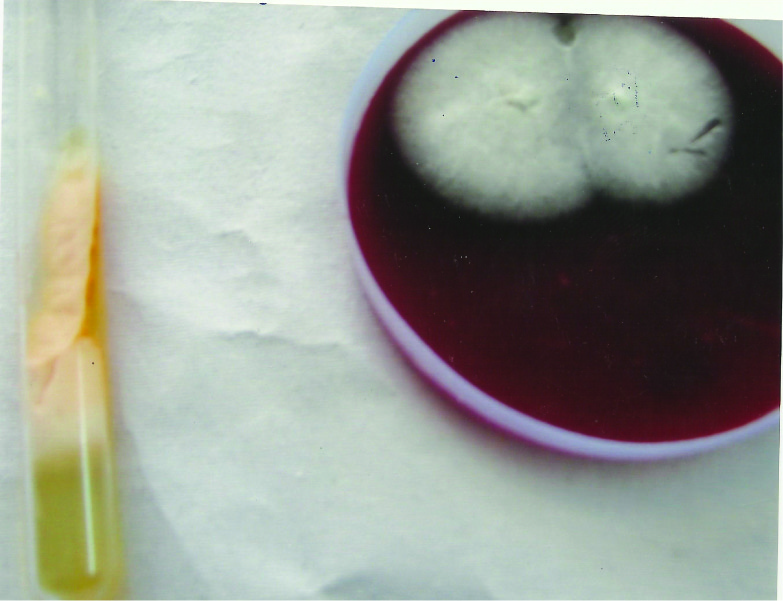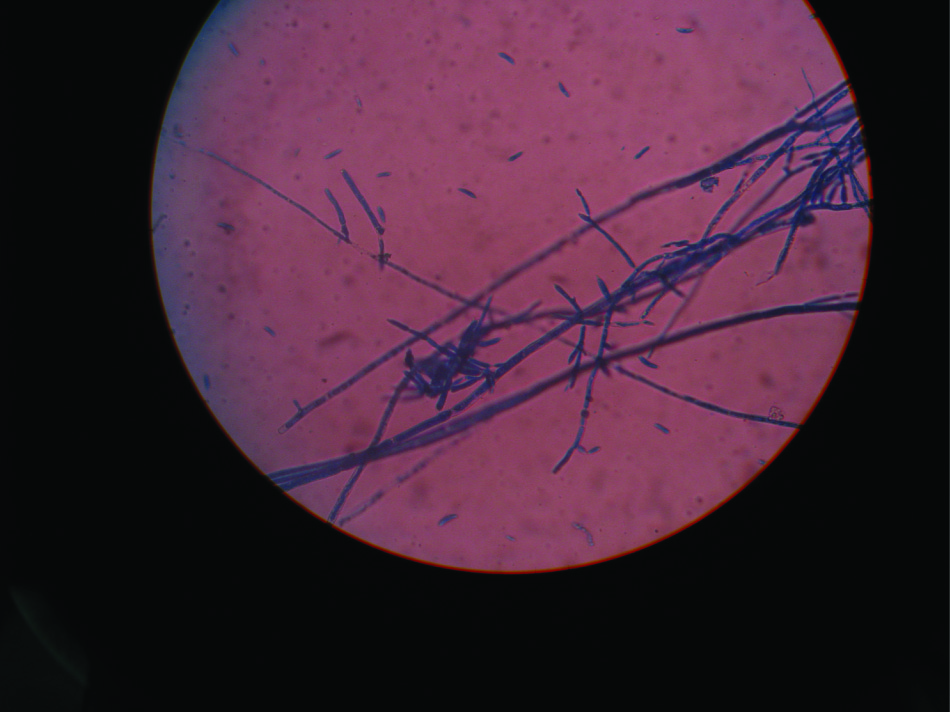Keratomycosis: Etiology, Risk Factors and Differential Diagnosis- A Mini Review on Trichophyton spp.
Yukti Sharma1, Sanjay Jain2, Jayachandran3
1 Specialist, Department of Microbiology, NDMC & Hindu Rao Hospital, Delhi, India.
2 CMO NFSG (Chief Medical Officer Non functional Selection Grade), Department of Microbiology NDMC & Hindu Rao Hospital, Delhi, India.
3 CMO, Department of Ophthalmology, NDMC & Hindu Rao Hospital, Delhi, India.
NAME, ADDRESS, E-MAIL ID OF THE CORRESPONDING AUTHOR: Dr. Yukti Sharma, 272 SFS DDA Flats Mukherjee Nagar, Delhi 110009, India. Phone : 9868467836, E-mail : dryukti2006@yahoo.com
Fungal keratitis is an infectious disease of the cornea. Lack of suspicion and delayed diagnosis herald the onset of complications often leading to permanent loss of vision or worse, enucleation. While a variety of pathogenic fungi especially non-dermatophyte molds associated with fungal keratitis have been identified, a comprehensive review identifying the Trichophyton spp. has not been completed. Trichophyton spp. is a rare but important entity implicated in fungal keratitis. Case reports from around the world designate it as a dangerous pathogen.
Trichophyton spp. implicated in keratitis has not previously been reported and is considerably greater than suggested by incidence studies. Patient outcome is heavily reliant upon correct identification, timely intervention and effective treatment. Species identification, the risk factors associated with, and pathogenesis of keratitis will allow the development of improved therapies. This mini review provides a resource for clinicians and researchers to recognize Trichophyton spp. as a potent etiological agent capable of causing keratitis. It is no more a dermatophyte limited to infection of appendages.
Corneal ulcer, Delhi, Trichophyton rubrum, Trichophyton erinacei
Case Report-1
A 45-year-old male agricultural worker presented with complaints of pain and defective vision in the right eye for one week [Table/Fig-1]. He gave history of foreign body in eye of unknown nature. There was blurred vision, redness, watering, pain and photophobia. On examination, the visual acuity was 5/60. Slit lamp evaluation of the right eye revealed a full thickness corneal ulcer. The margins of the ulcer were irregular, base appeared as a sloughing raised mass and the peripheral rim of the cornea was vascularized. Hypopyon filled the lower third of anterior chamber and ocular tension was fairly high. Using standard techniques, corneal scrapings, obtained by a sterile blade no 15 on Bard Parker handle, were inoculated directly onto Sabouraud’s media, corn-meal agar, blood agar, and mac conkey agar. These were incubated at room temperature for 4 to 6 wk. The growth of fungus was obtained within 8d to 14d and cultures were discarded after 45d. The fungi were isolated and identified by the study of growth characteristics, biochemical reactions and microscopic features. Direct microscopy revealed long, hyaline, septate, refractile hyphae. A white, velvety growth which was radially furrowed with obverse reddish pigmentation was identified from the culture after eight days. Microscopy revealed long, hyaline, septate branching hyphae with parallel walls along with pencil shaped macroconidia. Urea was put for biochemical identification and was positive. The fungus was identified as Trichophyton. The species was confirmed as rubrum [Table/Fig-2]. The fungus isolated was T.rubrum. Based on clinical impression, the patient was started on 5% topical natamycin drops along with 150 mg oral fluconazole twice a day. The patient’s condition deteriorated and evisceration was done.
Hypopyon in the right eye of patient no. 1

Case Report-2
A 53-year-old male driver by occupation presented with complaints of pain and defective vision in the right eye for one week [Table/Fig-1]. He did not recall any history of trauma but gave history of foreign body sensation. There was blurred vision, redness, persistent lacrimation, pain and photophobia. On examination, the visual acuity in the right eye was 2/60. Slit lamp evaluation revealed a hypopyon involving the nasal 1/3rd of the cornea and the adjacent limbus partly covering the pupillary area. The corneal scrapings were obtained and preceded in a similar way as mentioned above. The fungal growth was obtained in 8d. Direct microscopy revealed long, hyaline, septate, refractile hyphae. A white, velvety growth which was radially furrowed with obverse lemon-yellow pigmentation was observed. Microscopy revealed long, hyaline, septate branching hyphae with parallel walls along with pencil shaped macroconidia. Urease production was seen. The fungus was identified as Trichophyton erinacei [Table/Fig-3,4] for the second patient. The patient was advised to continue natamycin eye drops with itraconazole eye ointment. The ulcer healed in two weeks time with complete resolution of the infiltration. During follow-up after 10 mnth, he had a macular grade corneal scar with a best-corrected visual acuity of 6/18.
Photomicrograph of T.rubrum. note the pencil shaped macroconidia with abundant microconidia

T.erinacei characterized by its brilliant lemon yellow reverse pigment on sabouraud dextrose agar

Photomicrograph of T.erinacei. Microscopic features resemble T.rubrum with clavate/ tear drop shaped microconidia and large slender macroconidia

Literature review of corneal ulcer cases due to Trichophyton spp
| Year | Place | Species | | Treatment | Cause | Ref |
|---|
| 2011 | Saudi Arabia | Trichophyton spp. | | treated, evisceration | previous intraocular surgery and trauma | [6] |
| 2010 | Croatia | Trichophyton spp. | keratitis endoph-thalmitis | lost vision | contact lens | [7] |
| 2006 | Riyadh | Trichophyton schoenleinii | | 4 cured, 1 enucleation | trauma | [8] |
| 2003 | Oman | Trichophyton mentagrophytes | topical fluco-nazole | treated | trauma | [9] |
| 1973 | India, Jaipur | Trichophyton spp. | | | trauma | [10] |
| Present study | India, Delhi | Trichophyton rubrum, Trichophyton erinacei | | 1 cured, 1 evisceration | Both trauma | |
Discussion
Mycotic keratitis represents one of the major causes of infectious keratitis that has a worldwide distribution ranging from 17- 36%. Regional distribution of corneal ulcers in India are as follows- 7.3% in Northern India, 32% in East India, 38.9% in West India and 32% - 39.8% in Southern India [1–3]. This variation could be since fungal keratitis is expected to be more common in the tropical and subtropical regions than in the temperate regions. Any breach in the epithelial lining of cornea along with several extracellular enzymes like proteases, collagenases etc facilitates penetration of fungi further into the stroma. This further damages the eye integrity and results in loss of function. Invasion of the anterior chamber further heralds the onset of complications, often requiring surgery to get rid of the infection. Ocular infections caused by Fusarium solani in particular, have been reported to be associated with rapid deterioration including corneal perforation, whereas, dematiaceous fungi such as Curvularia tend to result in persistent low-grade infection and may present with a slightly pigmented lesion.
Both the patients with culture-proven fungal keratitis visited a physician prior to presentation at this institute but to no avail. It is interesting to note that both the patients presented within two weeks of onset of symptoms. Therefore, we believe that despite the patient being on prior antimicrobial/ antifungal therapy, microbiological investigation may succeed in establishing etiological diagnosis. Timely and appropriate intervention could have resulted in betterment of the results. Direct microscopic examination of corneal scrapings provides rapid diagnosis and forms the basis for instituting initial antimicrobial therapy which may be modified later according to culture reports [2,3]. An accurate smear diagnosis therefore becomes important in achieving optimum treatment outcome.
The first patient was an agricultural worker with an obvious source of infection but the second patient was a driver by profession. Trichophyton is a normal inhabitant of the conjunctiva [4]. Hereby, in the second patient, corneal ulcer might have been produced when the epithelium was denuded due to injury since no skin infection was noticed on face or scalp. Shtayeh et al., conducted an ecological study in Palestine [5]. Out of the fifty keratinophilic fungi studied, six were dermatophytes. Trichophyton mentagrophytes, T. rubrum and Epidermophyton floccosum have been commonly isolated from swimming pools. Polluted water habitats can be sources of environmental contamination and disease. People exposed to these environs are likely to contract fungal infection which is likely to be the cause in the present study. [Table/Fig-3] shows cases of fungal keratitis from India and abroad.
In the present cases trauma followed by delay in seeking medical opinion led to sequence of events as has been seen in other studies in [Table/Fig-3]. Most authors have reported Trichophyton spp., few reported subspecies schoenleinii. The present study reports the causative organisms as T. rubrum and T.erinacei.
Fungal keratitis is difficult to treat. Late presentation of the patient accompanied by the time consuming fungal confirmation reports further allay the initiation of antifungal therapy. Trichophyton is an uncommon cause of fungal keratitis that may be associated with progressive keratolysis and perforation, scleral extension, and endophthalmitis, if not treated promptly [Table/Fig-2].
Conclusion
There is paucity of data regarding mycotic keratitis from Northern India. This mini review provides a resource for clinicians and researchers to recognize Trichophyton spp. as a potent etiological agent capable of causing keratitis. Early diagnosis and thereby early treatment may help improve the management and outcome of keratomycosis. Lack of early intervention most often results in compromise in the patients vision and thereby in quality of life. To the best of our knowledge this is the first case report from north India where Trichophyton is the etiological agent implicated in corneal ulcer.
[1]. Gopinathan U, Garg P, Fernandez M, Sharma S, Athmanathan S, Rao GN, The epidemiological features and laboratory results of fungal keratitis: a 10 year review at a referral eye care centre in South IndiaCornea 2002 21:555-59. [Google Scholar]
[2]. Sharma S, Ocular infections: Research in IndiaIJMM 2010 28:91-94. [Google Scholar]
[3]. Jadhav SV, Prevalence of Fungal Keratitis from Tertiary Care Hospital from Western Part of IndiaInternational Journal of Microbiology Research 2012 :211-14. [Google Scholar]
[4]. Burd EM, Ogawa GSH, Hyndiuk RA, Bacterial keratitis and conjunctivitis. In: Smolin G, Thoft RA, eds. The corneaScientific foundations and clinical practice 1994 3rd edBostonLittle, Brown:115-67. [Google Scholar]
[5]. Ali Shtayeh MS, Khaleel M, Jamous M, Ecology of dermatophytes and other keratinophilic fungi in swimming pools and polluted and unpolluted streamsMycopathologia 2002 156:193-205. [Google Scholar]
[6]. Sabah S, Jastaneiah Ali A, Rajhi A, Abott D, Ocular mycosis at a referral centre in Saudi Arabia: A 20 year studySaudi Journal of Ophthalmology 2011 :231-38. [Google Scholar]
[7]. Mravicic I, Dekaris I, Gabric N, Trichophyton Spp. Fungal Keratitis in 22 Years Old Female Contact Lenses WearerCollegium Antropologicum 2010 34 [Google Scholar]
[8]. Mohammad Abdulkarim Rajhi A, Abdulaziz Michael W, Trichophyton FungalKeratitis Cornea 2006 25:118-22. [Google Scholar]
[9]. Shenoy R UAK, Shenoy ZH, Al Mahrooqui Keratomycosis due to Trichophyton mentagrophytesMycoses 2003 :157-58. [Google Scholar]
[10]. Kulshrestha OP, Bhargava S, Dube MK, Keratomycosis: A report of 23 casesIndian Journal of Opthalmology 1973 :51-55. [Google Scholar]